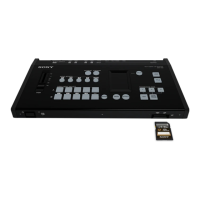
Do you have a question about the Sony MCX-500 and is the answer not in the manual?
| BNC input ports | 6 |
|---|---|
| BNC output ports | 2 |
| VGA (D-Sub) input ports | 1 |
| Product color | Black |
| Power consumption (typical) | 23 W |
| Depth | 206 mm |
|---|---|
| Width | 362 mm |
| Height | 43.5 mm |
| Weight | 2100 g |
Overview of the MCX-500's capabilities including switching, mixing, multi-viewer, and PC control.
Details the physical controls, connectors, and indicators on the unit.
Guides on connecting external equipment like cameras, computers, and displays.
Explains the procedures for turning the unit on, off, and initial setup.
Step-by-step guide for configuring initial settings upon first-time startup.
Instructions for connecting a computer to configure unit settings via the PC UI.
Process for assigning video and audio signals to the unit's input channels.
Describes simple operations for switching PGM output videos using basic controls.
Guides on using EFFECT mode for Picture-in-Picture (PinP) or other composite effects.
Instructions for overlaying text onto videos using RGB or HDMI input signals.
Covers real-time adjustments for audio levels, headphone volume, and panel brightness.
Detailed steps for adjusting chroma key parameters for background compositing.
Guides for adjusting text composition using RGB or HDMI signals.
Covers linking cameras for simultaneous recording control and tally light functions.
Detailed setup for linking cameras via a Remote Commander for control and tallies.
Instructions for formatting memory cards to be used with the unit.
Covers configuring Ustream streaming and controlling transmissions.
Steps to configure user login, password, and video size for Ustream streaming.
Guides on recording PGM outputs to memory cards and managing recording settings.
Covers formatting memory cards and configuring settings for remote commander linking.
Details on selecting recording format, bit rate, and timecode settings.
Guides on configuring network settings for connecting to external networks for streaming.
Covers configuring system settings like time zone, date/time, and system format.
Guides on diagnosing and resolving common operational problems and error messages.
A table of common symptoms, their possible causes, and solutions.
Detailed technical specifications for the unit's hardware and supported formats.